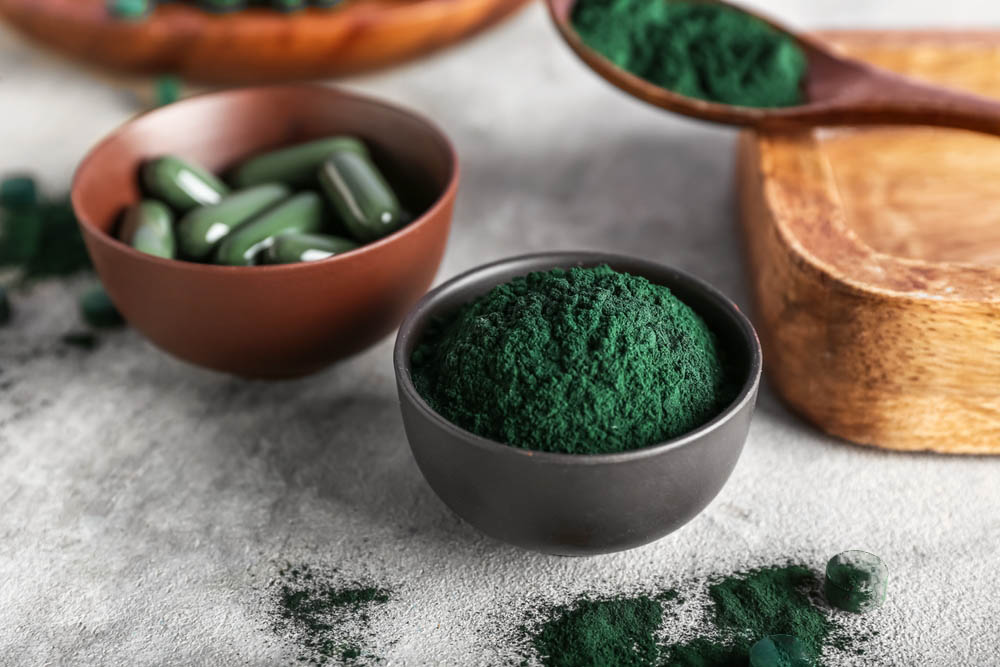SPIRULINA ALGAE
What it is, history and geography
Did you know?
Recognised as the Superfood of the 21st century and considered a food of the future by the FAO (Food and Agriculture Organisation of the United Nations), the Spirulina algae is rich in nutraceutical properties perfect for improving your body’s well-being.

Spirulina algae is a microalgae that belongs to the phylum Cyanobacteria, the first photosynthetic organism to appear on earth about 3.5 billion years ago. Its scientific name is Arthrospira platensis and it is better known as Spirulina because of its characteristic spiral shape that is only visible under a microscope.
It is also commonly referred to as blue algae or blue-green algae, which is due to the peculiar colouring of its photosynthetic pigment outfit.
It grows in freshwater lakes with moderate temperatures and high amounts of sunlight.
Benessere per tutto l’organismo
L’alga Spirulina è considerata un Superfood grazie alle sue numerose proprietà nutraceutiche e alla ricchezza di macro e micronutrienti.
È indicata per tutte quelle persone che vogliono abbracciare uno stile di vita sano. Contiene infatti un elevato quantitativo di proteine vegetali (50- 70% del peso secco), vitamine del gruppo B, vitamina E, vitamina K, pigmenti naturali (clorofilla a, xantofille, β-carotene, zeaxantina, c-ficocianina). Molto rilevante il contenuto di acidi grassi essenziali Omega 6 e sali minerali. Tra questi ultimi l’elemento più abbondante è il potassio ma è elevato anche il contenuto di fosforo, calcio, ferro, magnesio, rame e zinco.
Il profilo proteico è caratterizzato da tutti gli aminoacidi essenziali in quantità bilanciate.
Ossa più forti
Remineralizza le ossa.
Protezione
Azione antiossidante e antinfiammatoria.
Equilibrio
Aiuta a ripristinare l’equilibrio acido-base dei tessuti.
Prevenzione
Esercita un’azione protettiva sulla vista, sul sistema nervoso e sul cuore.
Spirulina algae will be soon available in our Shop!

Well-being for the whole body
Spirulina algae is considered a Superfood due to its numerous nutraceutical properties and wealth of macro- and micronutrients.
It is suitable for all people who want to embrace a healthy lifestyle. It contains a high amount of vegetable protein (50-70% of dry weight), B vitamins, vitamin E, vitamin K, natural pigments (chlorophyll a, xanthophylls, β-carotene, zeaxanthin, c-phycocyanin). The content of Omega 6 essential fatty acids and mineral salts is very significant. Among the latter, the most abundant element is potassium, but the content of phosphorus, calcium, iron, magnesium, copper and zinc is also high.
The protein profile is characterized by all essential amino acids in balanced quantities.
Stronger bones
Remineralizes bones.
Balance
Helps restore the acid-base balance of tissues.
Protection
Antioxidant and anti-inflammatory action.
Prevention
Excercises protective action on the eyesight, nervous system and heart.
Historical and geographical background
Its distribution mainly covers Africa but also affects some areas in Asia and South America. The places of origin are believed to be the alkaline lakes located in the Sudan-Sahel area, with epicentre in Lake Chad in Africa and those in the Rift Valley.
Many countries, including Mexico, the United States, India, Thailand, Myanmar, China, Cuba and Japan, are large producers of this cyanobacterium.
During the Spanish invasion to conquer Mexico, the use of this microalgae by local populations was noted. The Aztecs were considered to be among the first to use it, collected from Lake Texcoco (16th century). Similarly, the Kanembou Tribe, settled along the shores of Lake Chad in Africa, also used dried Spirulina as their main nutritional food.


